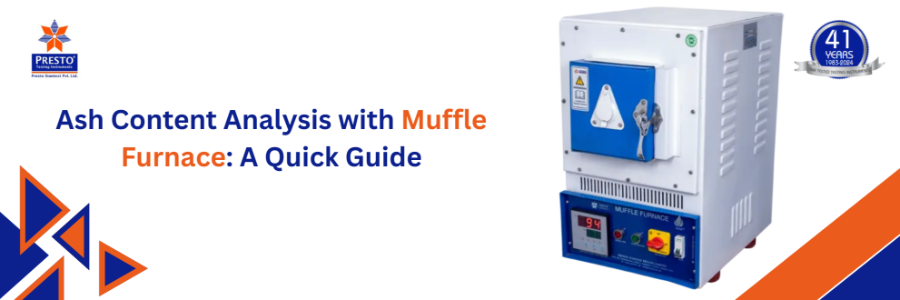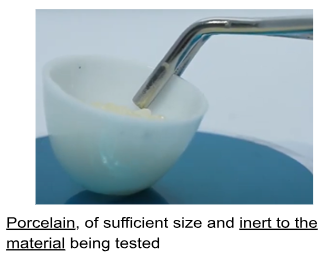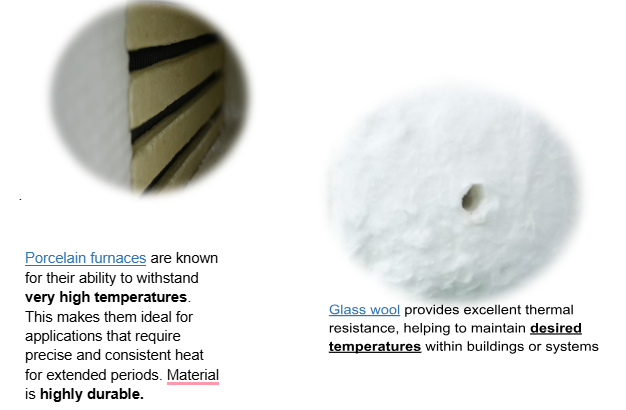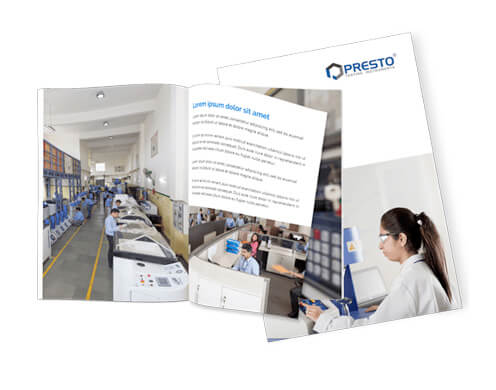Ash Content Analysis with Muffle Furnace: A Quick Guide

Vishal Malhotra-Testing Instrument Expert
14-05-2025
Within the recondite precincts of analytical chemistry and pharmacognosy, the ascertainment of ash content stands as an indispensable praxis for interrogating the veracity, immaculacy, and constitutional essence of a substance. The muffle furnace, an instrument of cardinal significance, effectuates this endeavor with matchless exactitude and probity. This disquisition expounds the labyrinthine intricacies of ash content determination, probing the muffle furnace working principle, its multifarious utilities, the ash value formula, and its cardinal import in ash value in pharmacognosy. By attaining mastery over the uses of muffle furnace in laboratory milieus and the stringent methodologies buttressing ash value evaluation, erudites and practitioners can procure outcomes of irreproachable precision and replicability.
Constitution of a Muffle Furnace
A muffle furnace embodies a consummate high-temperature calcination apparatus, meticulously contrived to incinerate or calcine specimens within a hermetically sequestered environment, thereby insulating the sample from adventitious impurities and combustion effluents. The epithet "muffle" designates the thermally insulated compartment that divorces the specimen from the caloric source, ensuring equable heating untainted by external perturbations. Capable of achieving temperatures ranging from 500°C to 1800°C, muffle furnaces are sine qua non for undertakings such as ash content analysis, material characterization, and thermic processing.
Muffle Furnace Diagram
Conceive a schematic delineation of the muffle furnace:
- Exostructure: A fortified carapace, typically wrought from stainless steel, encasing the apparatus in its entirety.
- Thermic Insulation: A mantle of preeminent ceramic or refractory substance enveloping the calcination chamber to obviate thermal dissipation.
- Calorific Elements: Electrically actuated coils or rods ensconced within the chamber’s perimeter, engendering prodigious thermal energy.
- Muffle Compartment: The sanctum sanctorum wherein specimens are lodged, fashioned from alumina or quartz to withstand extreme thermic rigors.
- Thermostatic Regulator: A digital or analog mechanism for scrupulous calibration and oversight of temperature and temporal parameters.
- Effluvial Conduit: A minute aperture for expelling combustion gases, preserving the chamber’s pristine condition.
This architectural paradigm ensures uniform thermic exposure devoid of direct flame interaction, a linchpin for rigorous ash content analysis.
Muffle Furnace Working Principle
The muffle furnace working principle reposes on meticulously orchestrated high-temperature incineration. Electrically energized calorific elements radiate intense thermal energy into the muffle compartment, where the insulating mantle sustains a stable, elevated temperature. The specimen, ensconced within a refractory crucible (typically porcelain or silica), undergoes calcination, transmuting organic constituents into ash whilst volatile fractions are vaporized or combusted.
A refined thermostatic regulator governs the calcination trajectory, permitting precise calibration to conform to procedural exigencies. For ash content analysis, the furnace is customarily set to 500–600°C to effectuate exhaustive organic combustion without vitiating the inorganic residuum. The absence of direct flame contact and the compartment’s sequestration preclude contamination, rendering the muffle furnace an exemplar of analytical stringency.
Uses of Muffle Furnace in Laboratory
The uses of muffle furnace in laboratory domains are manifold, traversing a panoply of scientific disciplines:
- Ash Content Quantification: Discerning the inorganic residuum in pharmaceuticals, comestibles, and botanical matrices, pivotal in ash value in pharmacognosy.
- Material Characterization: Investigating the thermic resilience and composition of ceramics, alloys, and polymeric substances.
- Loss on Ignition (LOI): Quantifying mass diminution upon thermic exposure, pertinent to geological and cementitious inquiries.
- Specimen Pre-treatment: Extirpating organic matter to prepare samples for advanced chemical or spectroscopic scrutiny.
- Thermic Processing: Executing annealing, sintering, or calcination to modulate material attributes.
In pharmacognosy, the muffle furnace is preeminent for ascertaining ash value, a metric elucidating the inorganic constituency of crude drugs and herbal preparations, thereby safeguarding their authenticity and quality.
Exegesis of Ash Value
The ash value denotes the inorganic detritus persisting post-calcination within a muffle furnace, comprising minerals, salts, and oxides impervious to thermic annihilation. Expressed as a percentile of the specimen’s primordial mass, ash value serves as a cornerstone for quality assurance in pharmaceuticals, comestibles, and agronomy.
Variants of Ash Value
In pharmacognosy, ash value manifests in diverse modalities:
Total Ash Value: The aggregate inorganic detritus post-exhaustive calcination, encompassing all mineral and extraneous constituents.
Acid-Insoluble Ash Value: The ash fraction recalcitrant to dilute hydrochloric acid, indicative of siliceous impurities such as sand.
Water-Soluble Ash Value: The ash component soluble in aqueous media, reflecting water-soluble salts.
Sulphated Ash Value: The residuum derived post-sulfuric acid treatment, mandated by specific pharmacopoeial edicts.
Each modality unveils distinct facets of the specimen’s constitution, facilitating the discernment of adulterants or impurities.
Ash Value Formula
Ash Value (%) = ((M3 − M1) / (M2 − M1)) × 100
Where:
- M1 = Mass of empty crucible
- M2 = Mass of crucible + sample (before heating)
- M3 = Mass of crucible + ash (after heating)
Steps:
- Weigh the empty crucible (M1).
- Add the sample (2–5 g), weigh it with crucible (M3).
- Heat in furnace at 500–600°C for 3–6 hours until ash forms.
- Cool, then weigh crucible with ash (M3).
- Use the formula to calculate ash content.
Note: For acid-insoluble or water-soluble ash, treat the ash with acid or water before calculation.
Ash Value in Pharmacognosy
Within the purview of ash value in pharmacognosy, ash content analysis constitutes a fundament for quality appraisal of crude drugs and herbal concoctions. Medicinal flora harbor inorganic elements such as calcium, potassium, magnesium, and silica, which contribute to their ash profile. Excessive ash, however, may betray contamination with terrestrial impurities, vitiating the drug’s sanctity.
Total ash value illuminates the holistic inorganic content, while acid-insoluble ash excels in unmasking adulteration with siliceous matter. For instance, an elevated acid-insoluble ash value in a botanical specimen may signify contamination with sand or silica, indicative of substandard harvesting or processing. Pharmacopoeial compendia, such as the Indian Pharmacopoeia or United States Pharmacopeia, prescribe permissible ash value thresholds to enforce quality compliance.
Illustrative Computation
Consider a 4 g specimen of pulverized turmeric rhizome subjected to total ash analysis:
- Mass of empty crucible ((M_1)) = 25.000 g
- Mass of crucible + specimen ((M_2)) = 29.000 g
- Mass of crucible + residuum ((M_3)) = 25.200 g
Ash Value (%) = ((29.000 − 25.000) / (25.200 − 25.000)) × 100 = (4.000 / 0.200) × 100 = 5.00%
This 5% ash value, when juxtaposed against pharmacopoeial benchmarks (e.g., a maximum of 6%), affirms the specimen’s conformity.
ASTM D5630- Standard Test Method for Ash Content with Muffle furnace Technique
This test method was developed to determine the inorganic content of plastics by destructive ashing procedures. The Presto muffle furnace is used to determine the ash content of a specimen. The percentage of ash in a material gives important insights into the properties of the substance.
These ashing procedures are used only to quantify the residual solids in the polymer and cannot be used to identify the individual chemical components of the ash, qualitatively.
Importance of checking ash content in samples
Inorganic residues from plastics ashing may be antiblock, fillers, reinforcements, catalyst residues, colorants, etc. The quantitative amounts of each are important variables of the manufacturing process.
How to perform ash content analysis with a Muffle furnace?
Pre ashing procedure- Weigh a clean, dry porcelain and keep the value as W1 .Weigh approximately the amount of material given into the weighed crucible. Record the resulting value as W2.

Place the crucible containing the sample into a Muffle Furnace—Electric-resistance-heated or microwave-heated furnace, capable of maintaining a temperature of 900 ± 25°C.
Weigh the cooled crucible, and record the resulting value of W3.

Comparative Ash Value Standards
The following tabulation delineates archetypal ash value thresholds for select medicinal flora as per pharmacopoeial edicts:
| Medicinal Flora | Total Ash Value (% Max) | Acid-Insoluble Ash Value (% Max) |
| Ginseng Radix | 6.0 | 1.0 |
| Curcuma Rhizoma | 7.0 | 1.5 |
| Glycyrrhiza Radix | 10.0 | 2.0 |
| Senna Folium | 12.0 | 3.0 |
This tabulation underscores the heterogeneity in ash content across botanical matrices, necessitating adherence to bespoke standards to ensure quality.
Best Practices for Ash Content Analysis
To procure outcomes of unimpeachable veracity, adhere to these precepts:
Specimen Homogenization: Pulverize the specimen to a uniform granularity to promote equitable calcination.
Crucible Selection: Employ porcelain or silica crucibles resilient to thermic extremes and chemically inert.
Thermic Calibration: Maintain the prescribed temperature (e.g., 550°C for total ash) to avert volatilization of inorganic constituents.
Desiccation: Cool crucibles in a desiccator to mitigate hygroscopic errors in mass determination.
Instrument Calibration: Periodically calibrate the muffle furnace and analytical balance to uphold precision.
Safety Protocols: Don thermic-resistant gauntlets and ocular protection when manipulating incandescent crucibles, and ensure adequate ventilation to dissipate calcination effluents.
Frequently Asked Questions (FAQs)
Q1. What is the import of acid-insoluble ash in pharmacognosy?
Ans. Acid-insoluble ash quantifies siliceous contaminants, such as sand or soil, in herbal drugs. Elevated values may betoken adulteration or improper curation, compromising the drug’s integrity.
Q2. Why is a muffle furnace favored over open-flame calcination for ash analysis?
Ans. The muffle furnace ensures a sequestered, contamination-free milieu by insulating the specimen from combustion effluents and extraneous impurities, yielding outcomes of superior fidelity.
Q3. Can the same crucible be reutilized for successive ash analyses?
Ans. Affirmative, provided the crucible is scrupulously cleansed and desiccated to eliminate residual detritus or contaminants. Porcelain or silica crucibles are robust for repeated employment if unmarred.
Q4. How does thermic variation impinge upon ash value determination?
Ans. Excessive temperatures may volatilize certain inorganic compounds, underestimating ash value, while inadequate temperatures may fail to incinerate organic matter comprehensively, overestimating the residuum. Adherence to 500–600°C is imperative.
Final Thoughts on Muffle Furnaces
The muffle furnace stands as an indomitable bulwark in ash content analysis, furnishing a sanctified milieu for calcining specimens and quantifying their ash value. By apprehending the muffle furnace working principle, its laboratory utilities, and the ash value formula, erudites can rigorously evaluate the quality of pharmaceuticals, comestibles, and botanical matrices. In pharmacognosy, ash value emerges as a sentinel metric for unmasking adulteration and ensuring fidelity to regulatory edicts. Through meticulous praxis and adherence to exacting standards, the muffle furnace delivers outcomes of enduring precision, cementing its status as a cornerstone of analytical science.
Get the Best Muffle Furnaces Price Today!
Looking for reliable Muffle Furnaces at competitive prices? Contact us now at +91 9210 903 903 or email us at info@prestogroup.com to receive the latest pricing and more information. Don't miss out on high-quality Muffle Furnaces at unbeatable prices
Recent News
- Paper & Packaging Testing Instruments
- Paint, Plating & Coating Testing Instruments
- Plastic & Polymer Testing Instruments
- Environmental Testing Chambers
- PET & Preform Testing Instruments
- Color Measuring Testing Instruments
- View Entire Range Instruments

Catalogue 2023
Get information about new product launches, research, innovation and endeavors at Presto.
download Free CopyNeed more information
Connect with us for your business enquiries. Generally we respond within one or two working days.
send enquiriesContact Us
Get a Quote
